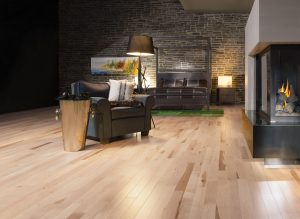Natural maple floor is prized for its smooth grain, light color, and clean appearance. It delivers a modern, airy feel to interior spaces while offering excellent durability. Maple is a top choice for those seeking a neutral wood tone that adapts to both traditional and contemporary design settings.

Visual Qualities
Maple is known for its consistent texture and subtle grain patterns. Unlike oak or hickory, it lacks deep color contrasts, creating a more uniform, refined look. Its natural color ranges from creamy white to pale tan, sometimes with faint mineral streaks.
Light Reflectivity
The bright tone of maple enhances natural light, making rooms feel larger and more open. It’s especially suitable for smaller spaces or homes with minimal windows, as it contributes to a fresh, expansive atmosphere.
Minimalist Appeal
Because of its subtle grain and light color, natural maple fits well with minimalist or Scandinavian interiors. It serves as a versatile backdrop for modern furniture, metal accents, or monochromatic color schemes.
Performance and Durability
Maple is a strong, dense wood, slightly softer than hickory but still well-suited for high-traffic areas. It holds up well under daily wear, making it popular in both residential and commercial spaces.
Janka Hardness Rating
Maple has a Janka rating of around 1450, indicating solid resistance to dents and scratches. This makes it a practical option for entryways, kitchens, and family rooms.
Wear and Tear Resistance
Its closed grain resists moisture absorption better than many open-grained hardwoods, though it’s still important to clean spills quickly and avoid excess humidity. Regular maintenance will preserve the floor’s smooth finish and natural luster.
Installation and Compatibility
Natural maple flooring comes in both solid and engineered formats, offering flexibility for different types of subfloors and climates.
Solid Maple Flooring
Solid maple should be nailed or stapled down and is ideal for above-grade installations. It can be sanded and refinished multiple times, extending its lifespan over decades.
Engineered Maple Flooring
Engineered maple has a layered core and a real maple veneer on top. It’s more dimensionally stable and can be installed as a floating floor or glued down, making it ideal for basements or areas with fluctuating humidity.
Maintenance Guidelines
With proper care, a natural maple floor can maintain its beauty for many years. Its smooth surface helps hide dust, but it does require gentle cleaning methods to avoid surface damage and moldy.
Cleaning Routine
Use a dry microfiber mop or vacuum with a hardwood floor attachment to remove dust and dirt. Avoid abrasive cleaners or excessive water. For occasional deeper cleaning, use a pH-neutral hardwood floor cleaner recommended by the manufacturer.
Preventative Measures
Use floor mats at entry points, felt pads under furniture legs, and area rugs in high-traffic zones. Keep indoor humidity between 35% and 55% to minimize expansion and contraction of the wood planks.
Design Pairings
Natural maple floors serve as a versatile foundation for a wide range of interior styles, thanks to their understated elegance and light color tone.
Modern and Contemporary Spaces
Pairing maple with white walls, glass accents, and metal fixtures enhances a modern look. It brings warmth to minimalist designs without overwhelming the space.
Transitional and Traditional Interiors
When combined with darker cabinets or furniture, maple flooring balances visual weight and adds a soft contrast. Its neutral palette allows for flexible updates to décor over time without replacing the flooring.




